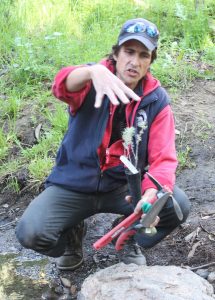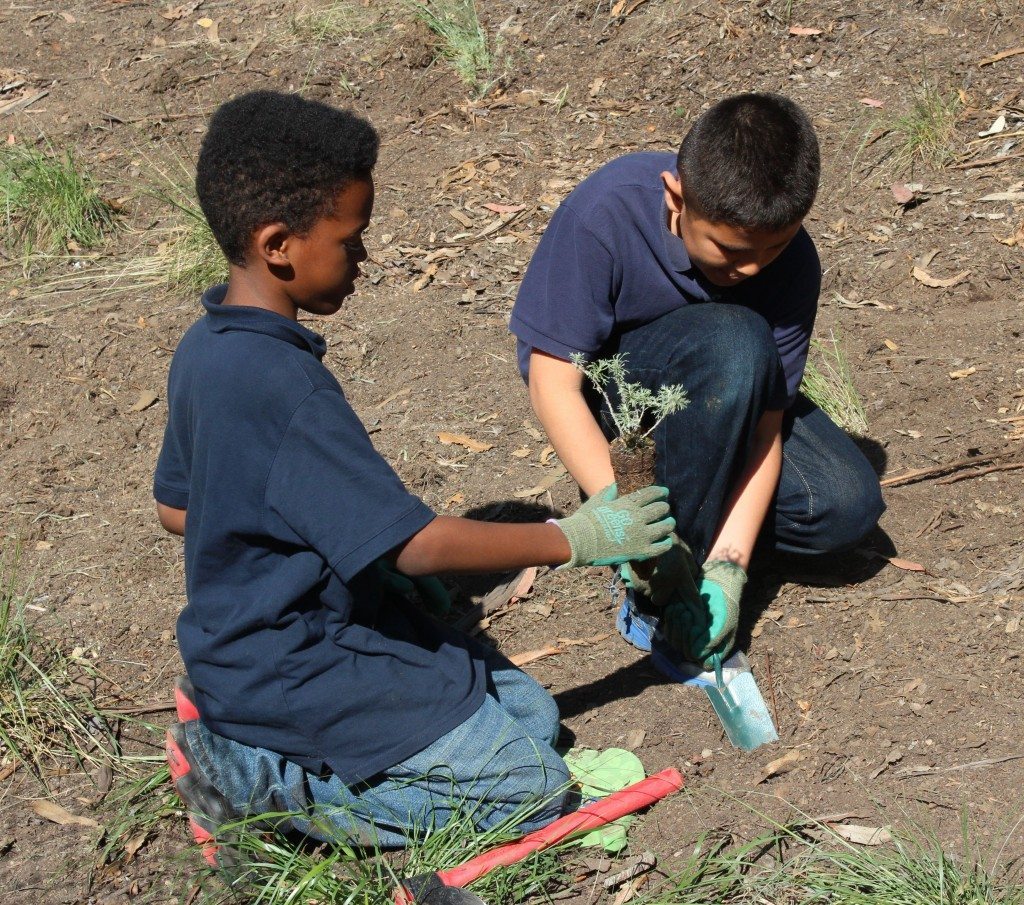Arroyo Viejo Creek becomes an outdoor classroom
By Pipi Ray Diamond
On the first day of spring, twenty third-grade students from Oakland Unified School District’s Korematsu Discovery Academy bravely head into the outdoors. They are accompanied by their teacher, several parents, one grandparent, volunteers, and their leaders — Anthony DeCicco and Marissa Ortega-Welch, who work with 700 low-income schoolchildren each year in Golden Gate Bird Alliance’s award-winning Eco-Education program.
Their destination is the Arroyo Viejo Creek, just outside the Oakland Zoo in Knowland Park. Seven years ago this portion of the creek was restored to provide better habitat for wildlife and increase human access. Many institutions collaborated to make it happen, including the California Coastal Conservancy, City of Oakland, Oakland Zoo and Urban Creeks Council. The restoration project also resulted in the perfect outdoor classroom.
This is the students’ second Eco-Ed field trip. In the fall, they visited Arrowhead Marsh where they went birding and planted wetland plants to support endangered Clapper Rails. Today they are here to explore the creek habitat – to see what lives here and understand how the creek is connected to the Bay.

The class splits into two groups. Anthony takes one group over to an open area that needs more native plants. The students gather around as he orients them. Pointing to the creek, he asks “What is the name for this?”
One excited boy yells out “A sewer!”
Anthony looks surprised but waits for more answers.
Unfortunately, the boy’s answer is not as silly as it sounds. The day before, volunteers from Friends of Sausal Creek discovered a sewage spill in that nearby creek. City staff recommended that people stay out of Sausal Creek until further notice.
A lot of work goes into making sure that local creeks are safe places for an outdoor classroom. Seeing the kids crawling over the banks and touching the water, I remind myself not to take water quality for granted.
Anthony keeps the kids focused and engaged with lots of call and response.
“A fancy word for a creek is ‘riparian.’ Can you say it?”
The children chant back, “Riparian!”
Anthony explains today’s project: planting sagebrush. He asks, “How will this plant be helpful to animals? Like a rabbit or a bird?”
“They can hide,” one student says.
“Correct,” says Anthony. “The plants will provide shelter for animals to hide from predators.” Then he shows them a shovel they’ll use for digging. “Is this a toy?”
“No,” the children say together.
“That’s right. It’s not a toy; it’s a tool.” Anthony finishes the safety lesson and the students pair up to start planting.


Meanwhile, Marissa’s group is exploring another part of the creek. All their senses are engaged. One Eco-Ed volunteer helps students listen for and identify bird calls. Marissa passes around a bent leaf from a bay laurel tree for them to smell, and students sip nectar from the base of flowers they’ve picked.
The lessons are spontaneous and relevant. When Marissa sees a child getting close to poison oak, she points it out with a rhyme:
“Leaves of three, let it be.
If it’s hairy, it’s a berry.
If it’s shiny, watch your hiney.”
One student spots a lizard on a tree, its head bobbing up and down. Marissa explains that the behavior is a warning to stay back.
Marissa especially likes Arroyo Viejo creek as an outdoor classroom because it is a safe space where the students can spread out and explore. Yet they eagerly come back to tell her what they’ve discovered — whether it’s a newt, a dragonfly or a Turkey Vulture.
“They rarely get the chance to have unstructured time like this in nature,” she says. “If our students play outside at all, it’s usually to play sports. It’s great for them to also have this opportunity to look for salamanders, spot birds in trees, and feel the dirt.”


In the Eco-Education program, students learn how the creek is connected to the bay and the ocean and what happens when trash enters this system. But today, simply experiencing a natural creek habitat through all their senses seems just as important a lesson.
——————————–
Come join the fun and volunteer with kids to make a difference! Golden Gate Bird Alliance’s Eco-Education program serves 700 elementary school children and their families in low-income communities in East Oakland, Richmond and San Francisco. In 2008, it won the Governor’s Environmental and Economic Leadership Award for Children’s Environmental Education. For more information, see the Eco-Ed volunteer page of our web site. To volunteer, contact Anthony at adecicco@goldengatebirdalliance.org.
To visit Arroyo Viejo Creek, take 580 East to the Golf Links Road/98th Ave exit. Turn left on Golf Links Road and go under the freeway. Park along Mountain Blvd. and walk to the zoo entrance. The trail starts just past the zoo entrance gate but before the toll booth on the left.
———————————–
Pipi Ray Diamond lives in Oakland. Her marketing consulting business at SongSparrowMarketing.com is named after one of her favorite birds. She volunteers for Golden Gate Bird Alliance and manages GGBA’ social media Pinterest site. Check it out for beautiful photos of Bay Area birds and more: http://www.pinterest.com
